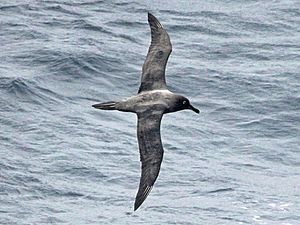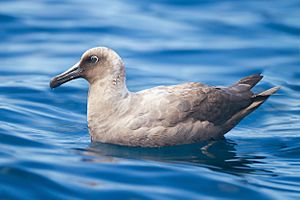Sooty albatross facts for kids
Quick facts for kids Sooty albatross |
|
|---|---|
 |
|
| Conservation status | |
| Scientific classification | |
| Genus: |
Phoebetria
|
| Species: |
fusca
|
The Sooty Albatross is a large sea bird. It is also known as the Dark-mantled Sooty Albatross or Dark-mantled Albatross. Its scientific name is Phoebetria fusca. These birds live and breed on islands in the southern parts of the Atlantic and Indian Oceans. They fly across the Southern Ocean, from South America all the way to Australia.
Contents
About Sooty Albatrosses
Sooty Albatrosses are a type of albatross. Albatrosses belong to a bird group called Diomedeidae. They are also part of a larger group called Procellariiformes. This group includes birds like shearwaters, fulmars, and petrels.
Birds in this group share some special features:
- They have unique nose tubes called naricorns on their upper beak.
- Their beaks are also special, made of 7 to 9 hard plates.
- They can make a special stomach oil. This oil is stored in their stomach and helps them in two ways. It can be used to spray at predators to protect themselves. It's also a rich food source for their chicks and gives adults energy during long flights.
- They have a salt gland above their nose. This gland helps them remove extra salt from their bodies. They need this because they drink a lot of seawater. The gland lets out a salty liquid from their nose.
What They Look Like
The Sooty Albatross is a medium-sized albatross. It is about 85 centimeters (33 inches) long. Its wings can spread out to about 2 meters (6.5 feet) wide. Adult birds usually weigh between 2.1 and 3.4 kilograms (4.6 to 7.5 pounds).
This albatross is mostly a sooty-brown color. The sides of its head are a bit darker. It has a white crescent shape just above and behind its eye. Its beak is black, with a bright orange or yellow line along the side. The tail of this albatross is wide and shaped like a diamond.
Young Sooty Albatrosses look a lot like the adults. However, they might have lighter feathers on their neck and upper back. This can sometimes make them look similar to the Light-mantled Albatross.
Behaviour
Feeding Habits
Sooty Albatrosses eat a variety of foods from the ocean. Their diet includes:
- Squid
- Crabs and other crustaceans
- Octopuses and other cephalopods
- Fish
- Dead animals they find floating in the water
Reproduction and Life Cycle
Sooty Albatrosses live in groups, but their colonies are not as big as those of some other albatrosses. Their groups usually have about 50 to 60 pairs of birds. They build their nests on cliffs and steep slopes, which helps keep their eggs and chicks safe.
Even though they can mate every year, they usually only breed every two years. This gives them enough time to raise their chicks and recover before the next breeding season.
Where They Live
These albatrosses build their nests on islands in the southern Atlantic Ocean. These islands include Gough Island and the Tristan da Cunha group. They also nest on islands in the Indian Ocean, such as the Prince Edward Islands, the Crozet Islands, Amsterdam Island, and the Kerguelen Islands.
When they are not breeding, they search for food in both the Atlantic and Indian Oceans. They can fly as far north as about 30 degrees South latitude.
Conservation Status
The IUCN lists the Sooty Albatross as an endangered bird. This means their numbers are decreasing and they are at risk of disappearing.
In 1998, scientists estimated there were about 42,000 adult Sooty Albatrosses. Over the last 90 years, their population has shrunk by about 75%. However, in recent years, the rate of decline has slowed down. For example, the population on Gough Island has been stable in the 21st century.
The main threats to Sooty Albatrosses include:
- Cats: On Amsterdam Island and the Kerguelen Islands, wild cats sometimes eat their eggs and chicks.
- Diseases: Diseases like avian cholera, pasteurellosis, and erysipelas are also big dangers to these birds.
Many efforts are being made to protect the Sooty Albatross:
- Studies and surveys are done to help understand and slow down their population decline.
- They are a protected species on the Tristan da Cunha group of islands.
- Gough Island is a World Heritage Site, which means it's a very important place to protect.
- Prince Edward Island, Gough Island, and Inaccessible Island (in the Tristan da Cunha group) are protected nature preserves.
- In 2007, the Crozet Islands, Amsterdam Island, and the Kerguelen Islands were also made nature preserves.
Images for kids
See also
 In Spanish: Albatros ahumado para niños
In Spanish: Albatros ahumado para niños




